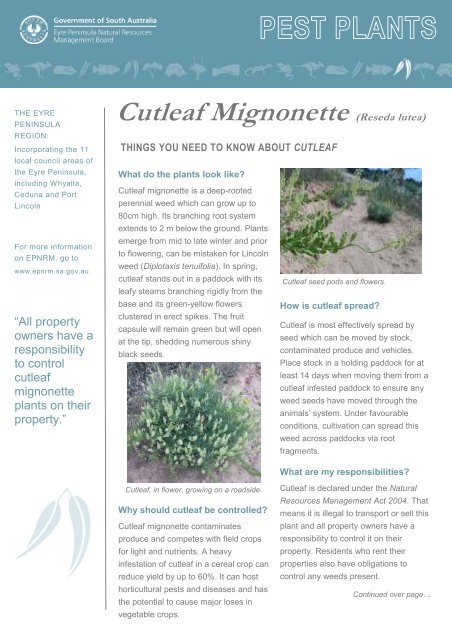Cutleaf Mignonette - Eyre Peninsula Natural Resources ...
Cutleaf Mignonette - Eyre Peninsula Natural Resources ...
Cutleaf Mignonette - Eyre Peninsula Natural Resources ...
Create successful ePaper yourself
Turn your PDF publications into a flip-book with our unique Google optimized e-Paper software.
THE EYRE<br />
PENINSULA<br />
REGION:<br />
Incorporating the 11<br />
local council areas of<br />
the <strong>Eyre</strong> <strong>Peninsula</strong>,<br />
including Whyalla,<br />
Ceduna and Port<br />
Lincoln<br />
For more information<br />
on EPNRM, go to<br />
www.epnrm.sa.gov.au<br />
“All property<br />
owners have a<br />
responsibility<br />
to control<br />
cutleaf<br />
mignonette<br />
plants on their<br />
property.”<br />
<strong>Cutleaf</strong> <strong>Mignonette</strong> (Reseda lutea)<br />
THINGS YOU NEED TO KNOW ABOUT CUTLEAF<br />
What do the plants look like?<br />
<strong>Cutleaf</strong> mignonette is a deep-rooted<br />
perennial weed which can grow up to<br />
80cm high. Its branching root system<br />
extends to 2 m below the ground. Plants<br />
emerge from mid to late winter and prior<br />
to flowering, can be mistaken for Lincoln<br />
weed (Diplotaxis tenuifolia). In spring,<br />
cutleaf stands out in a paddock with its<br />
leafy steams branching rigidly from the<br />
base and its green-yellow flowers<br />
clustered in erect spikes. The fruit<br />
capsule will remain green but will open<br />
at the tip, shedding numerous shiny<br />
black seeds.<br />
<strong>Cutleaf</strong> seed pods and flowers.<br />
How is cutleaf spread?<br />
<strong>Cutleaf</strong> is most effectively spread by<br />
seed which can be moved by stock,<br />
contaminated produce and vehicles.<br />
Place stock in a holding paddock for at<br />
least 14 days when moving them from a<br />
cutleaf infested paddock to ensure any<br />
weed seeds have moved through the<br />
animals’ system. Under favourable<br />
conditions, cultivation can spread this<br />
weed across paddocks via root<br />
fragments.<br />
What are my responsibilities?<br />
<strong>Cutleaf</strong>, in flower, growing on a roadside.<br />
Why should cutleaf be controlled?<br />
<strong>Cutleaf</strong> mignonette contaminates<br />
produce and competes with field crops<br />
for light and nutrients. A heavy<br />
infestation of cutleaf in a cereal crop can<br />
reduce yield by up to 60%. It can host<br />
horticultural pests and diseases and has<br />
the potential to cause major loses in<br />
vegetable crops.<br />
<strong>Cutleaf</strong> is declared under the <strong>Natural</strong><br />
<strong>Resources</strong> Management Act 2004. That<br />
means it is illegal to transport or sell this<br />
plant and all property owners have a<br />
responsibility to control it on their<br />
property. Residents who rent their<br />
properties also have obligations to<br />
control any weeds present.<br />
Continued over page…
CONTACT EPNRM<br />
Whyalla<br />
Whyalla City Council Office<br />
Darling Tce.<br />
WHYALLA SA 5600<br />
Tel: 8640 3481<br />
Cleve<br />
25 Fourth Street<br />
CLEVE SA 5640<br />
Tel: 8628 2077<br />
Port Lincoln<br />
23, Napoleon Street<br />
PORT LINCOLN SA 5606<br />
Tel: 8682 7555<br />
Elliston<br />
Elliston Information Centre<br />
ELLISTON SA 5670<br />
Tel: 8687 9275<br />
Ceduna<br />
Shop 7 - Surprys Mall<br />
35 Poynton St<br />
CEDUNA SA 5690<br />
Tel: 8625 3060<br />
Wudinna<br />
Telecentre<br />
44 <strong>Eyre</strong> Highway<br />
WUDINNA SA 5652<br />
Tel: 8680 2901<br />
What are the best ways to<br />
control cutleaf mignonette?<br />
As for any weed, prevention is better<br />
than a cure so try to keep cutleaf off<br />
your property. Otherwise timing of<br />
control is important and plants should<br />
be destroyed before setting seed.<br />
Destroying the plants at the end of the<br />
growing season will not help to control<br />
the infestation. A program developed<br />
over a number of years including<br />
treatment in non-crop years is critical<br />
for control. A season should not be<br />
missed and control should be<br />
conducted every year until the<br />
infestation is eradicated.<br />
Physical removal: Small infestations<br />
can be hand pulled. Slashing is not<br />
effective and will encourage more<br />
growth of flowering stems and<br />
cultivating can spread root fragments<br />
into clean ground.<br />
Close-up of cutleaf flower and leaves<br />
It is important when removing plants<br />
that they are disposed of correctly, by<br />
deep burial or placed in garbage bags<br />
and into the normal rubbish bin if you<br />
have access to a garbage service.<br />
It is important not to place plants in<br />
the green waste bin.<br />
Chemical methods: Chemicals<br />
should be used when the plant is<br />
green and actively growing and not<br />
under any kind of stress (i.e. brown),<br />
and before flowering, usually during<br />
early spring.<br />
Chemicals registered in South<br />
Australia for the control of cutleaf<br />
mignonette by spot spraying include<br />
those based on the active ingredients<br />
picloram, metsulfuron-methyl or<br />
glyphosate.<br />
For treatment of cereal crops with<br />
boom-sprays use herbicides based on<br />
metsulfuron-methyl, MCPA or 2-4D<br />
amine, depending on cropping and<br />
pasture rotations.<br />
Note: 2-4D should not be used on<br />
adult cutleaf plants as they show<br />
resistance.<br />
These products are available from<br />
rural supplies or hardware stores.<br />
Labels of chemicals should always be<br />
read and instructions followed.<br />
For more information on cutleaf mignonette, contact your<br />
local EPNRM office (see contact details on this page).
















